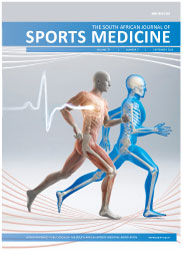Dynamic plantar pressure proles of South African university students
DOI:
https://doi.org/10.7196/SAJSM.565Abstract
Background. Footscan technology allows for assessment of injury risk and walking mechanics, yet there is a dearth of normative data
pertaining to the normal, injury-free foot in a South African (SA) context.
Objective. To generate normative tables from plantar pressure prole data gathered from students at an SA university.
Methods. e RS Footscan (RSscan, Belgium) system was used to measure the plantar pressure values of the foot. Ten anatomical landmarks
of the foot were analysed: the hallux, lateral toes, ve metatarsal heads, midfoot, and medial and lateral heel. ese ten areas were grouped
into one of three regions: forefoot, midfoot and heel. A total of 180 participants were subdivided as follows: gender (males, n=90; females,
n=90); race (black, n=60; white, n=60; coloured, n=60). Each race group comprised 30 males and 30 females.
Results. Of the ten individual plantar pressure areas, the second and third metatarsal heads demonstrated the highest mean peak plantar
pressure values. Of the three regions, the heel region was ascribed with the largest plantar pressure values. Black females, coloured males
and coloured females yielded the highest pressure values, especially under the midfoot region of the foot. Black and white males and white
females exhibited the lowest pressure under the foot, especially under the midfoot region.
Conclusion. e plantar pressure prole data generated in this study could serve to provide clinicians with a frame of reference when
evaluating participants within the age range of 18 - 30 years.
Downloads
Downloads
Published
Issue
Section
License
Copyright (c) 2015 South African Journal of Sports Medicine

This work is licensed under a Creative Commons Attribution 4.0 International License.
The South African Journal of Sports Medicine reserves copyright of the material published. The work is licensed under a Creative Commons Attribution 4.0 (CC BY 4.0) International License. Material submitted for publication in the South African Journal of Sports Medicine is accepted provided it has not been published elsewhere. The South African Journal of Sports Medicine does not hold itself responsible for statements made by the authors.
How to Cite
- Abstract 459
- PDF 521
Metrics

- Citations
- Citation Indexes: 2
- Usage
- Full Text Views: 2972
- Abstract Views: 320
- Captures
- Readers: 14





.png)